Winter storm? You need a Defender
By John Gilbert
It was completely appropriate that when a newly reborn 2021 Land Rover Defender was delivered to our home just outside Duluth, Minnesota, just as we were hit by a heavy snowstorm. It has been a weird winter on the North Shore of Lake Superior, with few storms, but most of them nasty, often with high winds followed by thermometer plunges.
To take on this particular storm we needed something to defend ourselves with, and what could be better than something named “Defender?”
The Defender has a rich history in the annals of Land Rover, although its role became obsolete when the company came out with all sorts of new models. So for its return, after a 23-year absence, Defender gets a very classy, contemporary restyling. Gone are the squarish corners that immediately identify Land Rovers and Range Rovers. Smoothly rounded corners make the new Defender look less rugged and more sophisticated. But I was reluctant to go driving off into the unplowed roadways because I didn’t want to mess it up, particularly after the car-wash reopened and took care of all the road glop to display a subtle, almost-pastel green color called Panges Green.
Then I realized that the Defender had been gone for all those years, without ever losing its familiarity — or its reputation. As a Land Rover, and not a Range Rover, the Defender was always aimed at adventurers who intended to use it to go anywhere, over and through any obstacles. It is the personification of the reason I first described Land Rovers as the vehicle you would choose if you had to drive to Hudson Bay — without using any roads.
The price is way up there — a base of $63,000 for the Defender SE model, and an as-tested sticker of $72,180. That is a lot, but it is less than loaded versions of, for example, a Cadillac Escalade, a GMC Yukon, a Ford Expedition, Lincoln Navigator and other luxury SUVs I’ve recently tested. And while it’s out of my price range, driving it for a week in “all terrain” Northern Minnesota roadways, I must say it has the substance to justify its price tag.
Two of the most prestigious names in sport-utility vehicles — dating back to well-before the trendy “SUV” catch-phrase came along — are Range Rover, and Land Rover. And both of them are from the same company, a proud British manufacturer that over-engineered its vehicles for use in wartime or peace, for work or pleasure, and only belatedly for being the classic luxury family hauler of the wealthy.
The company is Land Rover, and it makes a fleet of different Range Rovers, which meet all sorts of different objectives of class and luxury. The over-engineered trait is well-documented. The first Range Rover I ever drove was a few decades ago, and I learned that while it was shaped in a sort of squarish motif, it housed a remarkable living space of rich leather, with real wood and real metal trim. Just sitting in a Range Rover meant you found immediate strength and luxury.
It wasn’t until later that I learned the structure underneath Range Rovers was over-built for ruggedness, with frame rails that resembled structural girders. The least-qualified Range Rovers were still substantially built, and the equation also went the other way — the most hardy Land Rovers built to challenge the roughest terrain were also awash in luxury features.
British motor companies have fallen on difficult times, but Land Rover, and its British cousin, Jaguar, survived by finding benefactors who could finance their stubborn determination to build their vehicles to their own demands. Those first Land Rovers and Range Rovers I drove had aluminum V6 engines bought from Buick. Now, after the pair were jointly purchased and fionanced by Tata Motors in India, Jaguar makes outstanding sedans and sports cars and engines, and Land Rover makes its uncompromising SUVs and they’ve gained the high-tech engines from Jaguar.
The Defender is offered with either a high-output 2.0-liter 4 cylinder or, in the case of my test vehicle, a 3.0-liter in-line 6, that is turbocharged for high-end power, and awarded fantastic low-end torque via an electric supercharger that gets you up into the turbo’s range. In the Defender, I had the 3.0 in-line 6, and it produces 395 horsepower and 406 foot-pounds of torque in a range from 2,000 to 5,000 RPMs.
The engine is also equipped with a 48-volt motor-generator that brings the slick engine up to contemporary standards of the newest hybrid concepts of bolstering engine output instead of only improving fuel economy.
The Defender’s 8-speed ZF transmission worked smoothly and sent the 5,700-pound vehicle on its way swiftly. We got about 18.7 miles per gallon mostly in town or scaling the steep snowbound avenues of Duluth. I didn’t have to use the low-range transfer case, but a simple knob can easily switch you to full lock-up, or for whatever type of terrain you are hoping to conquer.
Land Rover did it right when it brought back the Defender, replacing the old truck-like body on frame platform for a new unibody design made mostly of aluminum, and they could do any tricks they wanted to with the suspension. The upscale SE model came with adaptive air suspension, the twin-speed transfer case for the all-wheel drive adds a terrain-response system with selectable driving and terrain modes, including off-road for whether you’re scaling boulders or making your way through ruts, controlling hill descent, or splashing through water up to 35.4 inches of depth.
The entire vehicle can be raised or lowered if you have nasty ruts ahead, and it has 11.5-inch clearance underneath. It also has a 38-degree approach angle and 40-degree departure angle without scraping those stylish body panels. All the latest safety features — lane recognition, lane-keep assist, electronic traction control, dynamic stability control and roll stability control, blind spot assist, driver condition monitor, emergency brake assist, adaptive cruise control with speed limiter, 400-watt Meridian audio system, and 360-degree monitor on the large navigation screen, are at your command.
The Defender drives smoothly on tires mounted on 20-inchalloy wheels, feeling like a boulevard cruiser without hinting that it would prefer to go charging off the road and tackle the boulders, woods and other terrain on either side.
My experience through the years with Land Rover includes some of the most fantastic introductory trips they could dream up. I attended a launch of the Discovery in Iceland, where we drove around the country on the one highway that circumnavigates the glaciers and volcanoes of that chilly paradise. They made sure we were warmly clad in special parkas made in Iceland for Iceland, and I hesitated to tell anyone that on that memorable week in January, it happened to be colder in Minnesota!
We also experienced a specific company made and company owned off-road course in Quebec. Another highlight remains unforgettable when we drove up into the Rocky Mountains to the Continental Divide, requiring some breathtaking trails best-suited for mountain goats or mules — but not humans, and certainly not motor vehicles.
Having experienced such ventures, I fully accept the intentions of all the details on the Defender’s price sticker as valid. The fact that the Defender would do all those things better than its Range Rover siblings is impressive, but now you add a third row of seats for kids and the ability to haul seven to the shopping center or on a trip — preferably after we get past the pandemic.
Firm comfort from the supportive seats and luxury that’s never ostentatious makes a welcoming interior, as expected from such a proud and demanding British manufacturer.
We can welcome back the Defender, because the new one not only will conquer every imaginable challenge, it also will be the Defender of Land Rover’s rich heritage. And you never know when you might want to take a trip to Hudson Bay without using any roads.


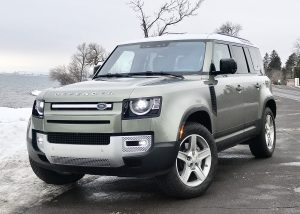

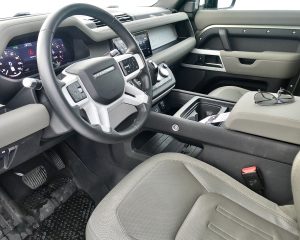
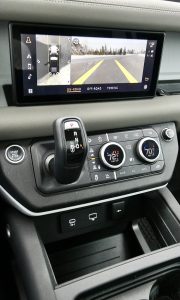
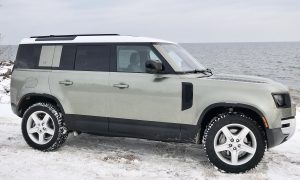
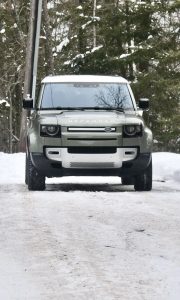
 John Gilbert is a lifetime Minnesotan and career journalist, specializing in cars and sports during and since spending 30 years at the Minneapolis Tribune, now the Star Tribune. More recently, he has continued translating the high-tech world of autos and sharing his passionate insights as a freelance writer/photographer/broadcaster. A member of the prestigious North American Car and Truck of the Year jury since 1993. John can be heard Monday-Friday from 9-11am on 610 KDAL(www.kdal610.com) on the "John Gilbert Show," and writes a column in the Duluth Reader.
John Gilbert is a lifetime Minnesotan and career journalist, specializing in cars and sports during and since spending 30 years at the Minneapolis Tribune, now the Star Tribune. More recently, he has continued translating the high-tech world of autos and sharing his passionate insights as a freelance writer/photographer/broadcaster. A member of the prestigious North American Car and Truck of the Year jury since 1993. John can be heard Monday-Friday from 9-11am on 610 KDAL(www.kdal610.com) on the "John Gilbert Show," and writes a column in the Duluth Reader.